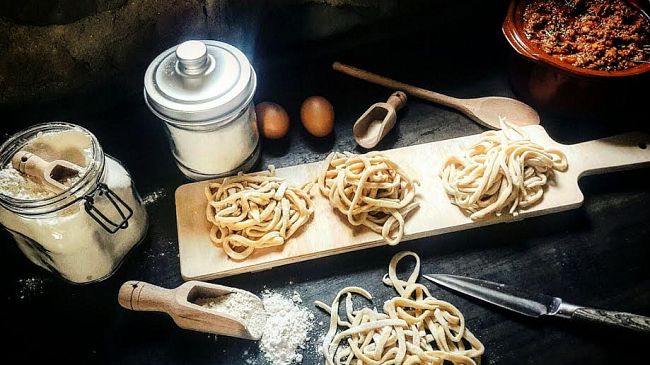Il rischio principale è quello di lasciare alla carne quel retrogusto di “selvatico” che risulta aggressivo e sgradevole, ma ci sono anche altri aspetti che vanno attentamente valutati… la giusta frollatura della carne ed il corretto tempo di cottura sono sicuramente essenziali per la buona riuscita del piatto.
Per chi è alle prime armi con la cacciagione è certamente consigliabile partire con la carne di cinghiale che richiede minore dimestichezza rispetto ad esempio a cervo, capriolo, fagiano ecc. L’ulteriore vantaggio del cinghiale è che, se ben preparato, piace praticamente a tutti perché è al tempo stesso magro e saporito ed è ideale per organizzare pranzi o cene con numerosi invitati perché può essere lavorato e cotto molto prima di mettersi a tavola senza perdere nulla in termini di gusto e consistenza.
Personalmente adoro l’abbinamento della pasta fresca con il sugo di cacciagione, probabilmente anche per il mio spassionato amore per le tradizioni gastronomiche della Toscana!
Spero che questa ricetta sia per qualcuno di voi, come è stata per me, la prima di una lunga serie a base di cacciagione!!
Pasta fresca- Ingredienti (per 4 persone):
4 uova
400 g farina
Setacciate e disponete la farina a fontana sul piano di lavoro, poi formate un incavo nel centro e rompetevi, una alla volta, le uova che avrete tenuto a temperatura ambiente; aggiungete il sale (facoltativo).
Cominciando dall’interno, mescolate le uova con una forchetta o con un cucchiaio, prendendo man mano la farina dai bordi; lavorate poi con le mani l’impasto dall’esterno verso l’interno, amalgamando tutta la farina che si trova sul piano di lavoro. Nel caso l’impasto non dovesse raccogliere completamente la farina o risultasse leggermente duro, aggiungete uno o due cucchiai di acqua tiepida e continuate a impastare fino a quando non risulterà liscio e compatto.
Avvolgete dunque la pasta ottenuta nella pellicola trasparente e lasciatela riposare per circa 30 minuti in un luogo fresco e asciutto.
Dopo il riposo, la pasta fresca risulterà più morbida ed elastica: preparatevi quindi a stenderla. Infarinate il piano di lavoro e dotatevi di un mattarello. Prima di stenderla appiattite il vostro panetto effettuando una leggera pressione con le dita. Una delle tecniche migliori per stendere la sfoglia è arrotolare un'estremità dell'impasto sul mattarello, tenere ferma con una mano l'altra estremità della sfoglia e far scorrere quindi il mattarello. Occorre fare pressione quando si spinge il matterello verso l'esterno e diminuire la pressione quando si sposta il mattarello verso l'interno.
Fate fare un quarto di giro alla sfoglia e ripetete lo stesso movimento fino a quando non avrete ottenuto lo spessore desiderato. Continuate a lavorare con il mattarello, tenendo presente che la sfoglia dovrà avere uno spessore di circa 0,5 mm. Quando avrete ottenuto il giusto spessore, potete ottenere i formati di pasta desiderati. Per tagliatelle, tagliolini o pappardelle, infarinate la sfoglia, quindi arrotolatela su se stessa. Tagliate il rotolo in tante fettine che dovranno avere una diversa larghezza a seconda del formato scelto: dai 5 ai 7 mm per le tagliatelle; 2-3 mm per i tagliolini e 1,5-2 cm per le pappardelle.
Una volta tagliate le varie fette, srotolatele immediatamente e mettete la pasta su un panno o un piano infarinato. Per ottenere le lasagne, munitevi di una rotella taglia pasta e tagliate dei rettangoli 20x14 cm, oppure della dimensione che più si addice alla teglia che utilizzerete per la preparazione della lasagna. Basterà porre una striscia di ripieno sul rettangolo di sfoglia preparato per la lasagna e arrotolarlo per ottenere i cannelloni. Cosa fare dei ritagli di pasta avanzata? Niente di più semplice: i maltagliati!
Il Ragout di cinghiale è una ricetta tipica della maremma Toscana; c’è chi unisce alla carne più robusta e pungente del cinghiale quella di suino, io preferisco utilizzarla in purezza… In alcune vecchie ricette viene riutilizzato il vino della marinatura, lasciandogli quel gusto selvatico, io preferisco eliminarlo! In base al pezzo di cinghiale che avete potete scegliere il piatto da realizzare: pezzi piccoli sono ideali per il ragout, pezzi più grandi sono perfetti per lo spezzatino da accompagnare con polenta o purè di patate.
Ragout- Ingredienti:
1 kg cinghiale
150 g cipolla rossa
100 g sedano
150 g carota
3 spicchi d’aglio
Sale e pepe q.b.
Olio di oliva q.b.
1 bicchiere di Vino rosso per sfumare
Foglie di alloro
Rametti di rosmarino
500 g passata di pomodori
200 g pomodori maturi tipo piccadilly
Per la marinatura- Ingredienti:
1 l vino rosso
2 coste di sedano
2 carote
1 cipolla rossa grossa
Qualche bacca di ginepro
Qualche foglia di alloro
Rametti di rosmarino
2 spicchi d’aglio
Lavate la carne, eliminate le parti grasse e tagliatela a pezzetti. In una ciotola capiente mettete la carne e copritela completamente con un litro di vino rosso, aggiungete il sedano, la carota e la cipolla tagliti a pezzetti, qualche bacca di ginepro, alcune foglie di alloro, 2 rametti di rosmarino e gli spicchi d’aglio. Coprite con la pellicola trasparente e lasciate marinare 24 ore in frigorifero.
Trascorso il tempo della marinatura, prendete la carne, scolatela e buttate via la marinatura che avrà assorbito il sapore selvatico tipico del cinghiale. Tritate col coltello la carne. Prendete una padella antiaderente e fate cuocere la carne per qualche minuto: eliminate l’acqua che uscirà e tenete da parte la carne. In una casseruola fate soffriggere in un pò d’olio il sedano, la carota e la cipolla tritati finemente. Aggiungete gli spicchi d’aglio interi (sarà più facile eliminarli a fine cottura) e la carne tritata e dopo una decina di minuti, sfumate con il vino rosso. Unite i pomodori freschi tagliati a pezzi, la passata di pomodoro e le erbe aromatiche tritate. Aggiustate di sale e pepe. Cuocete a fuoco basso per circa due ore.
Ho scelto di fare 1 kg di ragout così da poterlo anche congelare, visto che è un procedimento abbastanza lungo.
Cuocete la vostra pasta in abbondante acqua bollente e salata. Nel frattempo trasferite il ragù in una pentola capiente, scolate la pasta e versatela nella padella con il condimento, mescolate fino ad amalgamare il tutto e servite le vostre pappardelle/ tagliatelle/ maltagliati al ragù di cinghiale ancora calde.
Buon appetito!
Cook game is never a trivial exercise. The main risk is to leave the flesh that aftertaste of "wild" that is aggressive and unpleasant, but there are also other aspects that should be carefully evaluated ... the correct ripening of the meat and the correct cooking time are definitely essential to the success of the dish.
For those who are beginners with game is certainly recommend starting with boar meat that requires less familiar than such as red deer, roe deer, pheasant etc. The added benefit of wild boar is which, if well prepared, like practically everyone why is both lean and flavorful and is ideal for business lunches or dinners with many guests because it can be worked and cooked much before coming to the table without losing anything in terms of taste and texture.
Personally I love the combination of fresh pasta with game sauce, probably for my love for culinary traditions of Tuscany!
I hope this recipe is for any of you as it was for me, the first of a long series based on game!!
Fresh pasta-ingredients (for 4 people):
4 eggs
400 g flour
Sieve and place the flour on the work surface, then formed a hollow in the centre and break the eggs, one at a time you have kept at room temperature; add salt (optional).
Starting from inside, stir the eggs with a fork or a spoon, taking as the flour from the edges; knead the dough with your hands from the outside to the inside, mixing all the flour which is located on the worktop. If the dough does not collect completely flour or is slightly hard, add one or two tablespoons of warm water and continue to knead until it is smooth and compact.
Wrap the dough in plastic wrap and let rest for about 30 minutes in a cool, dry place.
After resting, fresh pasta is more soft and elastic: so prepare to roll out. Flour the work surface and get a rolling pin. Before you roll out your dough flattened by lightly pressing with your fingers. One of the best techniques to spread out the dough is rolled up one end of the dough over the rolling pin, hold with one hand the other end of the sheet and slide so the rolling pin. We must apply pressure when pushing the rolling pin outwards and release pressure when you move the rolling pin inwards.
Take a quarter turn to browse and repeat the same motion until you have achieved the desired thickness. Continue to work with the rolling pin, bearing in mind that the dough must have a thickness of about 0.5 mm. When you've got the right thickness, you can get the desired pasta shapes. For tagliatelle, tagliolini or pappardelle, flour the dough, then roll it up on itself. Cut the roll into so many slices that will have a different width depending on the chosen format: from 5 to 7 mm for tagliatelle; 2-3 mm for tagliolini; 1.5- 2 cm for pappardelle.
Once cut the various slices, unroll immediately and put the dough on a floured cloth or a plan. To get the lasagna, equip yourself with a pasta cutter and cut rectangles 20x14 cm, or the size that best fits the pan you will use to prepare lasagna. Just put a strip of filling the rectangle of dough prepared lasagna and roll it up to get the cannelloni. What to do with scraps of dough? Nothing could be simpler: the "maltagliati"!
The Ragout of wild boar is a typical recipe of Tuscany. In some old recipes the marinating wine is reused, leaving the wild taste, I prefer to delete it! Based on the piece of the boar, you can choose the dish to realise: small parts are ideal for the ragout, larger pieces are perfect for stew served with polenta or mashed potatoes.
Ragout-Ingredients:
1 kg boar
150 g red onion
100 g celery
150 g carrots
3 cloves of garlic
Salt and pepper to taste.
Olive oil to taste.
1 glass of red wine to deglaze
Bay leaves
rosemary sprigs
500 g tomatoes
200 g ripe tomatoes type piccadilly
For the marinade-ingredients:
1 l red wine
2 sticks of celery
2 carrots
1 large red onion
A few juniper berries
Some bay leaf
Rosemary sprigs
2 cloves garlic
Wash the meat, remove the fat and cut into pieces. Place meat in a large bowl and cover it completely with a liter of red wine, add the celery, carrot and onion cutted into pieces, a few juniper berries, a few
bay leaves, 2 sprigs of rosemary and garlic cloves. Cover with plastic wrap and let marinate for 24 hours in the refrigerator.
After the time of marinating, take the meat, drain and throw away the marinade that has absorbed the flavor typical of wild boar. Chop the meat with a knife. Take a frying pan and cook the meat for a few minutes: eliminate the water that comes out and set aside the meat. In a saucepan, sauté in a little oil, celery, carrot and onion finely chopped. Add the whole cloves of garlic (it will be easier to take them out when the ragout is cooked) and the chopped meat and after about ten minutes, deglaze with the red wine. Add the chopped fresh tomatoes, tomato puree and chopped herbs. Season with salt and pepper. Cook over low heat for about two hours.
I chose to make 1 kg of meat sauce so that you can also freeze, since it is a fairly long process.
Cook your pasta in plenty of boiling, salted water. In the meantime transferred the sauce in a large saucepan, drain the pasta and pour into the pan with the sauce, stir to mix everything together and serve your pappardelle/tagliatelle/maltagliati with wild boar sauce while still hot.





